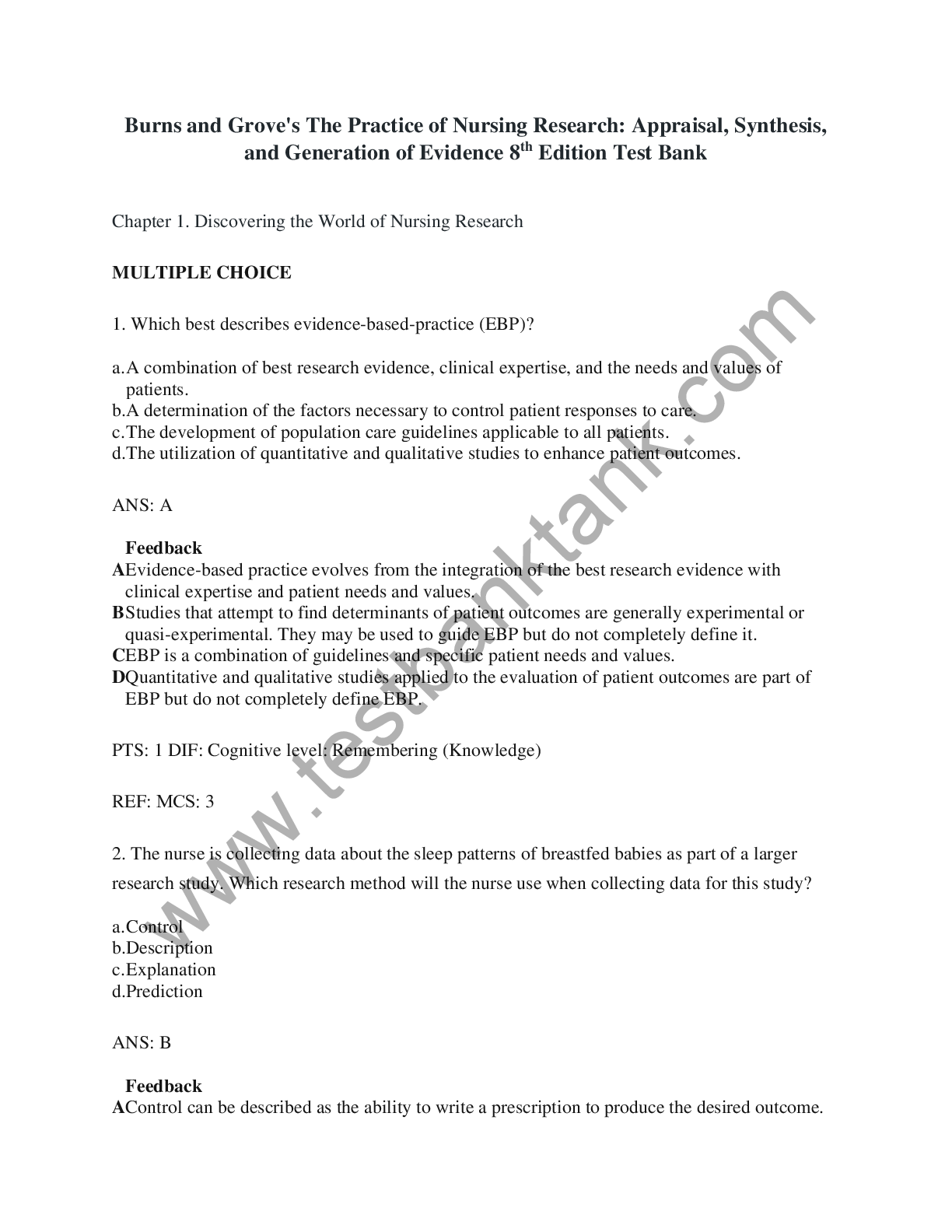*NURSING > TEST BANK > NUR 206 pharm exam 3 Lilley: Pharmacology and the Nursing Process, 8th Edition Test Bank,100% CORREC (All)
NUR 206 pharm exam 3 Lilley: Pharmacology and the Nursing Process, 8th Edition Test Bank,100% CORRECT
Document Content and Description Below
NUR 206 pharm exam 3 Lilley: Pharmacology and the Nursing Process, 8th Edition Test Bank Chapter 36: Antihistamines, Decongestants, Antitussives, and Expectorants Lilley: Pharmacology and the Nurs... ing Process, 8th Edition 1. When giving dextromethorphan, the nurse understands that this drug suppresses the cough reflex by which mechanism of action? a. Causing depression of the central nervous system b. Anesthetizing the stretch receptors c. Having direct action on the cough center Decreasing the viscosity of the bronchial secretions 2. During a routine checkup, a patient states that she is unable to take the prescribed antihistamine because of one of its most common adverse effects. The nurse suspects that which adverse effect has been bothering this patient? a. Constipation b. Abdominal cramps c. Drowsiness d. Decreased libido 3. A gardener needs a decongestant because of seasonal allergy problems and asks the nurse whether he should take an oral form or a nasal spray. Which of these is a benefit of orally administered decongestants? a. Immediate onset b. A more potent effect c. Lack of rebound congestion d. Shorter duration 4. A patient is taking guaifenesin (Humibid) as part of treatment for a sinus infection. Which instruction will the nurse include during patient teaching? a. Force fluids to help loosen and liquefy secretions. b. Report clear-colored sputum to the prescriber. c. Avoid driving a car or operating heavy machinery because of the sedating effects. d. Report symptoms that last longer than 2 days. 5. The nurse will instruct patients about a possible systemic effect that may occur if excessive amounts of topically applied adrenergic nasal decongestants are used. Which systemic effect may occur? a. Heartburn b. Bradycardia c. Drowsiness d. Palpitations 6. A patient with a tracheostomy has difficulty removing excessive, thick mucus from the respiratory tract. The nurse expects that which drug will be ordered to aid in the removal of mucus? a. Guaifenesin (Humibid) b. Benzonatate (Tessalon Perles) c. Diphenhydramine (Benadryl) d. Dextromethorphan (Robitussin DM) 7. A patient has been advised to add a nasal spray (an adrenergic decongestant) to treat a cold. The nurse will include which instruction? a. “You won’t see effects for at least 1 week.” b. “Limit use of this spray to 3 to 5 days.” c. “Continue the spray until nasal stuffiness has resolved.” d. “Avoid use of this spray if a fever develops.” 8. A patient asks the nurse about the uses of echinacea. Which use will the nurse include in the response? a. Memory enhancement b. Boosting the immune system c. Improving mood d. Promoting relaxation ANS: B Common uses of echinacea include stimulation of the immune system, antisepsis, treatment of viral infections and influenza-like respiratory tract infections, and promotion of the healing of wounds and chronic ulcerations. The other options are incorrect. DIF: COGNITIVE LEVEL: Understanding (Comprehension) REF: p. 566 TOP: NURSING PROCESS: Implementation MSC: NCLEX: Physiological Integrity: Pharmacological and Parenteral Therapies MULTIPLE RESPONSE 1. When teaching a patient who will be receiving antihistamines, the nurse will include which instructions? (Select all that apply.) a. “Antihistamines are generally safe to take with over-the-counter medications.” b. “Take the medication on an empty stomach to maximize absorption of the drug.” c. “Take the medication with food to minimize gastrointestinal distress.” d. “Drink extra fluids if possible.” e. “Antihistamines may cause restlessness and disturbed sleep.” f. “Avoid activities that require alertness until you know how adverse effects are tolerated.” 2. A patient tells the nurse that she wants to start taking the herbal product goldenseal to improve her health. The nurse will assess for which potential cautions or contraindications to goldenseal? (Select all that apply.) a. Taking a proton-pump inhibitor b. Nasal congestion c. Hypothyroidism d. Hypertension e. Sinus infections f. Pregnancy 1. A child will be receiving diphenhydramine (Benadryl), 5 mg/kg/day, in divided doses, every 6 hours. The child weighs 80 pounds. Identify how many milligrams of medication will the child receive with each dose. (record answer using one decimal place) ANS: 2. A patient will be receiving diphenhydramine (Benadryl) via a PEG tube, 25 mg, every 8 hours for an allergic rash. The medication is available as a 12.5 mg/5 mL syrup. Identify how many milliliters will the nurse administer with each dose. ANS: Chapter 37: Respiratory Drugs Lilley: Pharmacology and the Nursing Process, 8th Edition 1. A patient is taking intravenous aminophylline for a severe exacerbation of chronic obstructive pulmonary disease. The nurse will assess for which therapeutic response? a. Increased sputum production b. Increased heart rate c. Increased respiratory rate d. Increased ease of breathing 2. A patient is taking a xanthine derivative as part of treatment for chronic obstructive pulmonary disease. The nurse will monitor for which adverse effects associated with the use of xanthine derivatives? a. Diarrhea b. Palpitations c. Bradycardia d. Drowsiness 3. A patient is in an urgent care center with an acute asthma attack. The nurse expects that which medication will be used for initial treatment? a. An anticholinergic such as ipratropium (Atrovent) b. A short-acting beta2 agonist such as albuterol (Proventil) c. A long-acting beta2 agonist such as salmeterol (Serevent) d. A corticosteroid such as fluticasone (Flovent) 4. The prescriber has changed the patient’s medication regimen to include the leukotriene receptor antagonist (LTRA) montelukast (Singulair) to treat asthma. The nurse will emphasize which point about this medication? a. The proper technique for inhalation must be followed. b. The patient needs to keep it close by at all times to treat acute asthma attacks. c. It needs to be taken every day on a continuous schedule, even if symptoms improve. d. When the asthma symptoms improve, the dosage schedule can be tapered and eventually discontinued. 5. After receiving a nebulizer treatment with a beta agonist, the patient complains of feeling slightly nervous and wonders if her asthma is getting worse. What is the nurse’s best response? a. “This is an expected adverse effect. Let me take your pulse.” b. “The next scheduled nebulizer treatment will be skipped.” c. “I will notify the physician about this adverse effect.” d. “We will hold the treatment for 24 hours.” 6. A patient has prescriptions for two inhalers. One inhaler is a bronchodilator, and the other is a corticosteroid. Which instruction regarding these inhalers will the nurse give to the patient? a. “Take the corticosteroid inhaler first.” b. “Take the bronchodilator inhaler first.” c. “Take these two drugs at least 2 hours apart.” d. “It does not matter which inhaler you use first.” 7. When educating a patient recently placed on inhaled corticosteroids, the nurse will discuss which potential adverse effects? a. Fatigue and depression b. Anxiety and palpitations c. Headache and rapid heart rate d. Oral candidiasis and dry mouth 8. The nurse is monitoring drug levels for a patient who is receiving theophylline. The most recent theophylline level was 22 mcg/mL, and the nurse evaluates this level to be: a. below the therapeutic level. b. at a therapeutic level. c. above the therapeutic level. d. at a toxic level. 9. When evaluating a patient’s use of a metered-dose inhaler (MDI), the nurse notes that the patient is unable to coordinate the activation of the inhaler with her breathing. What intervention is most appropriate at this time? a. Notify the doctor that the patient is unable to use the MDI. b. Obtain an order for a peak flow meter. c. Obtain an order for a spacer device. d. Ask the prescriber if the medication can be given orally. 10. The nurse is providing instructions about the Advair inhaler (fluticasone propionate and salmeterol). Which statement about this inhaler is accurate? a. It is indicated for the treatment of acute bronchospasms. b. It needs to be used with a spacer for best results. c. Patients need to avoid drinking water for 1 hour after taking this drug. d. It is used for the prevention of bronchospasms. 1. The nurse is reviewing medications for the treatment of asthma. Which drugs are used for acute asthma attacks? (Select all that apply.) a. Salmeterol (Serevent) inhaler b. Albuterol (Proventil) nebulizer solution c. Epinephrine d. Montelukast (Singulair) e. Fluticasone (Flovent) Rotadisk inhaler 2. The nurse is providing instructions to a patient who has a new prescription for a corticosteroid metered-dose inhaler. Which statement by the patient indicates that further instruction is needed? (Select all that apply.) a. “I will rinse my mouth with water after using the inhaler and then spit out the water.” b. “I will gargle after using the inhaler and then swallow.” c. “I will clean the plastic inhaler casing weekly by removing the canister and then washing the casing in warm soapy water. I will then let it dry before reassembling.” d. “I will use this inhaler for asthma attacks.” e. “I will continue to use this inhaler, even if I am feeling better.” f. “I will use a peak flow meter to measure my response to therapy.” 1. A patient has a metered-dose inhaler that contains 200 actuations (‘puffs’), and it does not have a dose counter. He is to take two puffs two times a day. If he does not take any extra doses, identify how many days will this inhaler last at the prescribed dose. ANS: 50 days Note the number of doses in the canister, and then calculate the number of days that the canister will last. For this question, assuming that two puffs are taken two times a day, and the inhaler has a capacity of 200 inhalations. Two puffs two times a day equal four inhalations per day. Four divided into 200 yields 50; that is, the inhaler will last approximately 50 days. 2. A patient will be receiving oral theophylline (Theo-Dur), 600 mg/day, in three divided doses. Identify how many milligrams will the patient receive per dose. ANS: DIF: COGNITIVE LEVEL: Applying (Application) REF: N/A TOP: NURSING PROCESS: Implementation MSC: NCLEX: Physiological Integrity: Pharmacological and Parenteral Therapies Chapter 38: Antibiotics Part 1 Lilley: Pharmacology and the Nursing Process, 8th Edition 1. When reviewing the allergy history of a patient, the nurse notes that the patient is allergic to penicillin. Based on this finding, the nurse would question an order for which class of antibiotics? a. Tetracyclines b. Sulfonamides c. Cephalosporins d. Quinolones 2. The nurse is providing teaching to a patient taking an oral tetracycline antibiotic. Which statement by the nurse is correct? a. “Avoid direct sunlight and tanning beds while on this medication.” b. “Milk and cheese products result in increased levels of tetracycline.” c. “Antacids taken with the medication help to reduce gastrointestinal distress.” d. “Take the medication until you are feeling better.” 3. When reviewing the medication orders for a patient who is taking penicillin, the nurse notes that the patient is also taking the oral anticoagulant warfarin (Coumadin). What possible effect may occur as the result of an interaction between these drugs? a. The penicillin will cause an enhanced anticoagulant effect of the warfarin. b. The penicillin will cause the anticoagulant effect of the warfarin to decrease. c. The warfarin will reduce the anti-infective action of the penicillin. d. The warfarin will increase the effectiveness of the penicillin. 4. A patient is receiving his third intravenous dose of a penicillin drug. He calls the nurse to report that he is feeling “anxious” and is having trouble breathing. What will the nurse do first? a. Notify the prescriber. b. Take the patient’s vital signs. c. Stop the antibiotic infusion. d. Check for allergies. 5. A patient is admitted with a fever of 102.8° F (39.3° C), origin unknown. Assessment reveals cloudy, foul-smelling urine that is dark amber in color. Orders have just been written to obtain stat urine and blood cultures and to administer an antibiotic intravenously. The nurse will complete these orders in which sequence? a. Blood culture, antibiotic dose, urine culture b. Urine culture, antibiotic dose, blood culture c. Antibiotic dose, blood and urine cultures d. Blood and urine cultures, antibiotic dose 6. During drug therapy with a tetracycline antibiotic, a patient complains of some nausea and decreased appetite. Which statement is the nurse’s best advice to the patient? a. “Take it with cheese and crackers or yogurt.” b. “Take each dose with a glass of milk.” c. “Take an antacid with each dose as needed.” d. “Drink a full glass of water with each dose.” 7. The nurse is monitoring a patient who has been on antibiotic therapy for 2 weeks. Today the patient tells the nurse that he has had watery diarrhea since the day before and is having abdominal cramps. His oral temperature is 101° F (38.3° C). Based on these findings, which conclusion will the nurse draw? a. The patient’s original infection has not responded to the antibiotic therapy. b. The patient is showing typical adverse effects of antibiotic therapy. c. The patient needs to be tested for Clostridium difficile infection. d. The patient will need to take a different antibiotic. 8. The nurse is monitoring for therapeutic results of antibiotic therapy in a patient with an infection. Which laboratory value would indicate therapeutic effectiveness of this therapy? a. Increased red blood cell count b. Increased hemoglobin level c. Decreased white blood cell count d. Decreased platelet count 9. The nurse is reviewing the sputum culture results of a patient with pneumonia and notes that the patient has a gram-positive infection. Which generation of cephalosporin is most appropriate for this type of infection? a. First generation b. Second generation c. Third generation d. Fourth generation 10. A patient will be having oral surgery and has received an antibiotic to take for 1 week before the surgery. The nurse knows that this is an example of which type of therapy? a. Empiric b. Prophylactic c. Definitive d. Resistance 11. A patient has a urinary tract infection. The nurse knows that which class of drugs is especially useful for such infections? a. Macrolides b. Carbapenems c. Sulfonamides d. Tetracyclines 12. During drug therapy for pneumonia, a female patient develops a vaginal superinfection. The nurse explains that this infection is caused by: a. large doses of antibiotics that kill normal flora. b. the infection spreading from her lungs to the new site of infection. c. resistance of the pneumonia-causing bacteria to the drugs. d. an allergic reaction to the antibiotics. 13. The nurse is preparing to use an antiseptic. Which statement is correct regarding how antiseptics differ from disinfectants? a. Antiseptics are used to sterilize surgical equipment. b. Disinfectants are used as preoperative skin preparation. c. Antiseptics are used only on living tissue to kill microorganisms. d. Disinfectants are used only on nonliving objects to destroy organisms. 14. A patient with a long-term intravenous catheter is going home. The nurse knows that if he is allergic to seafood, which antiseptic agent is contraindicated? a. Chlorhexidine gluconate (Hibiclens) b. Hydrogen peroxide c. Povidone-iodine (Betadine) d. Isopropyl alcohol 1. During antibiotic therapy, the nurse will monitor closely for signs and symptoms of a hypersensitivity reaction. Which of these assessment findings may be an indication of a hypersensitivity reaction? (Select all that apply.) a. Wheezing b. Diarrhea c. Shortness of breath d. Swelling of the tongue e. Itching f. Black, hairy tongue 2. The nurse is reviewing the medication history of a patient who will be taking a sulfonamide antibiotic. During sulfonamide therapy, a significant drug interaction may occur with which of these drugs or drug classes? (Select all that apply.) a. Opioids b. Oral contraceptives c. Sulfonylureas d. Antihistamines e. Phenytoin (Dilantin) f. Warfarin (Coumadin) COMPLETION 1. A patient will be receiving amoxicillin suspension 300 mg via a gastrostomy tube every 8 hours. The medication comes in a bottle that contains 400 mg/5 mL. Identify how many milliliters will the nurse administer with each dose. (record answer using one decimal place) ANS: 2. A patient will be receiving penicillin G potassium, 12 million units daily in divided doses every 4 hours IVPB. Identify how many units will the patient receive for each dose each day. ANS: 2 million units If a medication is given every 4 hours, then there will be 6 doses in each 24-hour day. Chapter 39: Antibiotics Part 2 Lilley: Pharmacology and the Nursing Process, 8th Edition 1. When a patient is on aminoglycoside therapy, the nurse will monitor the patient for which indicators of potential toxicity? a. Fever b. White blood cell count of 8000 cells/mm3 c. Tinnitus and dizziness d. Decreased blood urea nitrogen (BUN) levels 2. The nurse is administering a vancomycin (Vancocin) infusion. Which measure is appropriate for the nurse to implement in order to reduce complications that may occur with this drug’s administration? a. Monitoring blood pressure for hypertension during the infusion b. Discontinuing the drug immediately if red man syndrome occurs c. Restricting fluids during vancomycin therapy d. Infusing the drug over at least 1 hour 3. Which nursing diagnosis is appropriate for a patient who has started aminoglycoside therapy? a. Constipation b. Risk for injury (renal damage) c. Disturbed body image related to gynecomastia d. Imbalanced nutrition, less than body requirements, related to nausea 4. A patient who has been hospitalized for 2 weeks has developed a pressure ulcer that contains multidrug-resistant Staphylococcus aureus (MRSA). Which drug would the nurse expect to be chosen for therapy? a. Metronidazole (Flagyl) b. Ciprofloxacin (Cipro) c. Vancomycin (Vancocin) d. Tobramycin (Nebcin) 5. A patient is receiving aminoglycoside therapy and will be receiving a beta-lactam antibiotic as well. The patient asks why two antibiotics have been ordered. What is the nurse’s best response? a. “The combined effect of both antibiotics is greater than each of them alone.” b. “One antibiotic is not strong enough to fight the infection.” c. “We have not yet isolated the bacteria, so the two antibiotics are given to cover a wide range of microorganisms.” d. “We can give a reduced amount of each one if we give them together.” 6. The nurse is reviewing the medication orders for a patient who will be receiving gentamicin therapy. Which other medication or medication class, if ordered, would be a potential interaction concern? a. Calcium channel blockers b. Phenytoin c. Proton pump inhibitors d. Loop diuretics 7. The nurse checks the patient’s laboratory work prior to administering a dose of vancomycin (Vancocin) and finds that the trough vancomycin level is 24 mcg/mL. What will the nurse do next? a. Administer the vancomycin as ordered. b. Hold the drug, and administer 4 hours later. c. Hold the drug, and notify the prescriber. d. Repeat the test to verify results. 8. A patient has been diagnosed with carbapenemase-resistant Enterobacteriaceae (CRE). The nurse expects to see orders for which drug? a. Dapsone (Cubicin), a miscellaneous antibiotic b. Ciprofloxacin (Cipro), a quinolone c. Linezolid (Zyvox), an oxazolidinone d. Colistimethate sodium (Coly-Mycin), a polypeptide antibiotic 9. A 79-year-old patient is receiving a quinolone as treatment for a complicated incision infection. The nurse will monitor for which adverse effect that is associated with these drugs? a. Neuralgia b. Double vision c. Hypotension d. Tendonitis and tendon rupture 1. The nurse is administering intravenous vancomycin (Vancocin) to a patient who has had gastrointestinal surgery. Which nursing measures are appropriate? (Select all that apply.) a. Monitoring serum creatinine levels b. Restricting fluids while the patient is on this medication c. Warning the patient that a flushed feeling or facial itching may occur d. Instructing the patient to report dizziness or a feeling of fullness in the ears e. Reporting a trough drug level of 11 mcg/mL and holding the drug f. Reporting a trough drug level of 24 mcg/mL and holding the drug 2. A patient will be receiving nitrofurantoin (Macrodantin) treatment for a urinary tract infection. The nurse is reviewing the patient’s history and will question the nitrofurantoin order if which disorder is present in the history? (Select all that apply.) a. Liver disease b. Coronary artery disease c. Hyperthyroidism d. Type 1 diabetes mellitus e. Chronic renal disease 1. A patient with a Pseudomonas species urinary infection will be receiving amikacin (Amikin) 15 mg/kg once daily via intravenous infusion. The patient weighs 198 pounds, and the medication is available in an injection solution strength of 250 mg/mL. Identify how many milliliters of medication will be drawn up for this injection. (record answer using one decimal place) ANS: DIF: COGNITIVE LEVEL: Applying (Application) REF: N/A TOP: NURSING PROCESS: Implementation MSC: NCLEX: Physiological Integrity: Pharmacological and Parenteral Therapies Chapter 40: Antiviral Drugs Lilley: Pharmacology and the Nursing Process, 8th Edition 1. A patient who is diagnosed with shingles is taking topical acyclovir, and the nurse is providing instructions about adverse effects. The nurse will discuss which adverse effects of topical acyclovir therapy? a. Insomnia and nervousness b. Temporary swelling and rash c. Burning when applied d. This medication has no adverse effects. 2. A patient who has undergone a lung transplant has contracted cytomegalovirus (CMV) retinitis. The nurse expects which drug to be ordered for this patient? a. Acyclovir (Zovirax) b. Ganciclovir (Cytovene) c. Ribavirin (Virazole) d. Amantadine (Symmetrel) 3. An infant has been hospitalized with a severe lung infection caused by the respiratory syncytial virus (RSV) and will be receiving medication via the inhalation route. The nurse expects which drug to be used? a. Acyclovir (Zovirax) b. Ganciclovir (Cytovene) c. Amantadine (Symmetrel) d. Ribavirin (Virazole) 4. A patient who is HIV- positive has been receiving medication therapy that includes zidovudine (Retrovir). However, the prescriber has decided to stop the zidovudine because of its dose- limiting adverse effect. Which of these conditions is the dose-limiting adverse effect of zidovudine therapy? a. Retinitis b. Renal toxicity c. Hepatotoxicity d. Bone marrow suppression 5. The nurse is administering intravenous acyclovir (Zovirax) to a patient with a viral infection. Which administration technique is correct? a. Infuse intravenous acyclovir slowly, over at least 1 hour. b. Infuse intravenous acyclovir by rapid bolus. c. Refrigerate intravenous acyclovir. d. Restrict oral fluids during intravenous acyclovir therapy. 6. A patient is receiving cidofovir (Vistide) as part of treatment for a viral infection, and the nurse is preparing to administer probenecid, which is also ordered. Which is the rationale for administering probenecid along with the cidofovir treatment? a. Probenecid has a synergistic effect when given with cidofovir, thus making the antiviral medication more effective. b. The probenecid also prevents replication of the virus. c. Concurrent drug therapy with probenecid reduces the nephrotoxicity of the cidofovir. d. The probenecid reduces the adverse gastrointestinal effects of the cidofovir. 7. A patient is taking a combination of antiviral drugs as treatment for early stages of a viral infection. While discussing the drug therapy, the patient asks the nurse if the drugs will kill the virus. When answering, the nurse keeps in mind which fact about antiviral drugs? a. They are given for palliative reasons only. b. They will be effective as long as the patient is not exposed to the virus again. c. They can be given in large enough doses to eradicate the virus without harming the body’s healthy cells. d. They may also kill healthy cells while killing viruses. 8. A young adult calls the clinic to ask for a prescription for “that new flu drug.” He says he has had the flu for almost 4 days and just heard about a drug that can reduce the symptoms. What is the nurse’s best response to his request? a. “Now that you’ve had the flu, you will need a booster vaccination, not the antiviral drug.” b. “We will need to do a blood test to verify that you actually have the flu.” c. “Drug therapy should be started within 2 days of symptom onset, not 4 days.” d. “We’ll get you a prescription. As long as you start treatment within the next 24 hours, the drug should be effective.” 9. The nurse is providing counseling to a woman who is HIV positive and has just discovered that she is pregnant. Which anti-HIV drug is given to HIV-infected pregnant women to prevent transmission of the virus to the infant? a. Acyclovir (Zovirax) b. Zidovudine (Retrovir) c. Ribavirin (Virazole) d. Foscarnet (Foscavir) 1. A patient who is diagnosed with genital herpes is taking topical acyclovir. The nurse will provide which teaching for this patient? (Select all that apply.) a. “Be sure to wash your hands thoroughly before and after applying this medicine.” b. “Apply this ointment until the lesion stops hurting.” c. “Use a clean glove when applying this ointment.” d. “If your partner develops these lesions, then he can also use the medication.” e. “You will need to avoid touching the area around your eyes.” f. “You will have to practice abstinence when these lesions are active.” 2. A patient is in the HIV clinic for a follow-up appointment. He has been on antiretroviral therapy for HIV for more than 3 years. The nurse will assess for which potential adverse effects of long-term antiretroviral therapy? (Select all that apply.) a. Lipodystrophy b. Liver damage c. Kaposi’s sarcoma d. Osteoporosis e. Type 2 diabetes 1. A patient with a viral infection is to receive ganciclovir (Cytovene) 5 mg/kg/day IVPB every morning. The patient weighs 110 pounds. Identify how many milligrams will this patient receive for this dose. ANS: DIF: COGNITIVE LEVEL: Applying (Application) REF: N/A TOP: NURSING PROCESS: Implementation MSC: NCLEX: Physiological Integrity: Pharmacological and Parenteral Therapies Chapter 41: Antitubercular Drugs Lilley: Pharmacology and the Nursing Process, 8th Edition 1. The nurse is discussing adverse effects of antitubercular drugs with a patient who has active tuberculosis. Which potential adverse effect of antitubercular drug therapy should the patient report to the prescriber? a. Gastrointestinal upset b. Headache and nervousness c. Reddish-orange urine and stool d. Numbness and tingling of extremities 2. A patient who has been taking isoniazid (INH) has a new prescription for pyridoxine. She is wondering why she needs this medication. The nurse explains that pyridoxine is often given concurrently with the isoniazid to prevent which condition? a. Hair loss b. Renal failure c. Peripheral neuropathy d. Heart failure 3. The nurse will assess the patient for which potential contraindication to antitubercular therapy? a. Glaucoma b. Anemia c. Heart failure d. Hepatic impairment 4. When monitoring patients on antitubercular drug therapy, the nurse knows that which drug may cause a decrease in visual acuity? a. Rifampin (Rifadin) b. Isoniazid (INH) c. Ethambutol (Myambutol) d. Streptomycin 5. A patient has been taking antitubercular therapy for 3 months. The nurse will assess for what findings that indicate a therapeutic response to the drug therapy? a. The chronic cough is gone. b. There are two consecutive negative purified protein derivative (PPD) results over 2 months. c. There is increased tolerance to the medication therapy, and there are fewer reports of adverse effects. d. There is a decrease in symptoms of tuberculosis along with improved chest x-rays and sputum cultures. 6. The nurse is counseling a woman who will be starting rifampin (Rifadin) as part of antitubercular therapy. The patient is currently taking oral contraceptives. Which statement is true regarding rifampin therapy for this patient? a. Women have a high risk for thrombophlebitis while on this drug. b. A higher dose of rifampin will be necessary because of the contraceptive. c. Oral contraceptives are less effective while the patient is taking rifampin. d. The incidence of adverse effects is greater if the two drugs are taken together. 7. The nurse is reviewing the medication administration record of a patient who is taking isoniazid (INH). Which drug or drug class has a significant drug interaction with isoniazid? a. Pyridoxine (vitamin B6) b. Penicillins c. Phenytoin (Dilantin) d. Benzodiazepines 8. A patient who has started drug therapy for tuberculosis wants to know how long he will be on the medications. Which response by the nurse is correct? a. “Drug therapy will last until the symptoms have stopped.” b. “Drug therapy will continue until the tuberculosis develops resistance.” c. “You should expect to take these drugs for as long as 24 months.” d. “You will be on this drug therapy for the rest of your life.” 9. The nurse is preparing to administer morning medications to a patient who has been newly diagnosed with tuberculosis. The patient asks, “Why do I have to take so many different drugs?” Which response by the nurse is correct? a. “Your prescriber hopes that at least one of these drugs will work to fight the tuberculosis.” b. “Taking multiple drugs reduces the chance that the tuberculosis will become drug resistant.” c. “Using more than one drug can help to reduce side effects.” d. “Using multiple drugs enhances the effect of each drug.” 10. A patient newly diagnosed with tuberculosis (TB) has been taking antitubercular drugs for 1 week calls the clinic and is very upset. He says, “My urine is dark orange! What’s wrong with me?” Which response by the nurse is correct? a. “You will need to stop the medication, and it will go away.” b. “It’s possible that the TB is worse. Please come in to the clinic to be checked.” c. “This is not what we usually see with these drugs. Please come in to the clinic to be checked.” d. “This is an expected side effect of the medicine. Let’s review what to expect.” 1. The nurse is providing patient teaching for a patient who is starting antitubercular drug therapy. Which of these statements should be included? (Select all that apply.) a. “Take the medications until the symptoms disappear.” b. “Take the medications at the same time every day.” c. “You will be considered contagious during most of the illness and must take precautions to avoid spreading the disease.” d. “Stop taking the medications if you have severe adverse effects.” e. “Avoid alcoholic beverages while on this therapy.” f. “If you notice reddish-brown or reddish-orange urine, stop taking the drug and contact your doctor right away.” g. “If you experience a burning or tingling in your fingers or toes, report it to your prescriber immediately.” h. “Oral contraceptives may not work while you are taking these drugs, so you will have to use another form of birth control.” Chapter 42: Antifungal Drugs Lilley: Pharmacology and the Nursing Process, 8th Edition 1. During an intravenous (IV) infusion of amphotericin B, a patient develops tingling and numbness in his toes and fingers. What will the nurse do first? a. Discontinue the infusion immediately. b. Reduce the infusion rate gradually until the adverse effects subside. c. Administer the medication by rapid IV infusion to reduce these effects. d. Nothing; these are expected side effects of this medication. 2. If a patient is taking fluconazole (Diflucan) with an oral anticoagulant, the nurse will monitor for which possible interaction? a. Reduced action of oral anticoagulants b. Increased effects of oral anticoagulants c. Hypokalemia d. Decreased effectiveness of the antifungal drug 3. The nurse is preparing an infusion of amphotericin B for a patient who has a severe fungal infection. Which intervention is appropriate regarding the potential adverse effects of amphotericin B? a. Discontinuing the infusion immediately if fever, chills, or nausea occur b. Gradually increasing the infusion rate until the expected adverse effects occur c. If fever, chills, or nausea occur during the infusion, administering medications to treat the symptoms d. Before beginning the infusion, administering an antipyretic and an antiemetic drug 4. The nurse is administering one of the lipid formulations of amphotericin B. When giving this drug, which concept is important to remember? a. The lipid formulations may be given in oral form. b. The doses are much lower than the doses of the older drugs. c. The lipid formulations are associated with fewer adverse effects than the older drugs. d. There is no difference in cost between the newer and older forms. 5. The nurse is reviewing instructions for vaginal antifungal drugs with a patient. Which statement by the nurse is an appropriate instruction regarding these drugs? a. “The medication can be stopped when your symptoms are relieved.” b. “Discontinue this medication if menstruation begins.” c. “Daily douching is part of the treatment for vaginal fungal infections.” d. “Abstain from sexual intercourse until the treatment has been completed and the infection has resolved.” 6. A patient is infected by invasive aspergillosis, and the medical history reveals that the patient has not been able to tolerate several antifungal drugs. The nurse anticipates an order for which medication to treat this infection? a. Fluconazole (Diflucan) b. Micafungin (Mycamine) c. Caspofungin (Cancidas) d. Nystatin (Mycostatin) 7. A patient with a severe fungal infection has orders for voriconazole (Vfend). The nurse is reviewing the patient’s medical record and would be concerned if which assessment finding is noted? a. Decreased breath sounds in the lower lobes b. History of cardiac dysrhythmias c. History of type 2 diabetes d. Potassium level of 4.0 mEq/L 8. During therapy with amphotericin B, the nurse will monitor the patient for known adverse effects that would be reflected by which laboratory result? a. Serum potassium level of 2.7 mEq/L b. Serum potassium level of 5.8 mEq/L c. White blood cell count of 7000 cells/mm3 d. Platelet count of 300,000/ microliter 9. A patient has received a prescription for a 2-week course of antifungal suppositories for a vaginal yeast infection. She asks the nurse if there is an alternative to this medication, saying, “I don’t want to do this for 2 weeks!” Which is a possibility in this situation? a. A single dose of a vaginal antifungal cream. b. A one-time infusion of amphotericin B. c. A single dose of a fluconazole (Diflucan) oral tablet. d. There is no better alternative to the suppositories. 10. A patient is taking nystatin (Mycostatin) oral lozenges to treat an oral candidiasis infection resulting from inhaled corticosteroid therapy for asthma. Which instruction by the nurse is appropriate? a. “Chew the lozenges until they are completely dissolved.” b. “Let the lozenge dissolve slowly and completely in your mouth without chewing it.” c. “Rinse your mouth with water before taking the inhaler.” d. “Rinse your mouth with mouthwash after taking the inhaler.” 1. The nurse is administering an amphotericin B infusion. Which actions by the nurse are appropriate? (Select all that apply.) a. Administering the medication by rapid IV infusion b. Discontinuing the drug immediately if the patient develops tingling and numbness in the extremities c. If adverse effects occur, reducing the IV rate gradually until they subside d. Using an infusion pump for IV therapy e. Monitoring the IV site for signs of phlebitis and infiltration f. Administering premedication for fever and nausea g. Knowing that the intravenous solution for amphotericin B will be cloudy h. Knowing that muscle twitching may indicate hypokalemia 1. A patient will be taking fluconazole (Diflucan) 100 mg/day PO for 2 weeks. The patient is unable to swallow tablets, so an oral suspension that contains 10 mg/mL is available. Identify how many milliliters will the nurse administer with each dose. ANS: DIF: COGNITIVE LEVEL: Applying (Application) REF: N/A TOP: NURSING PROCESS: Implementation MSC: NCLEX: Physiological Integrity: Pharmacological and Parenteral Therapies Chapter 43: Antimalarial, Antiprotozoal, and Anthelmintic Drugs Lilley: Pharmacology and the Nursing Process, 8th Edition 1. A patient who has a helminthic infection has a prescription for pyrantel (Antiminth). Which is one of the common adverse effects that the patient may experience while on this therapy? a. Vertigo b. Seizures c. Diarrhea d. Insomnia 2. A patient has an infestation with flukes. The nurse anticipates the use of which drug to treat this infestation? a. Praziquantel (Biltricide) b. Pyrantel (Pin-X) c. Metronidazole (Flagyl) d. Ivermectin (Stromectol) 3. A patient who is being treated for malaria has started therapy with quinine and tetracycline. He asks the nurse why he is on an antibiotic when malaria is caused by a parasite. Which response by the nurse is correct? a. “The tetracycline prevents reinfection by the malarial parasite.” b. “The antibiotic is combined with quinine to reduce the side effects of the quinine.” c. “An antibacterial drug prevents the occurrence of superinfection during antimalarial therapy.” d. “The two drugs are more effective against malaria when given together.” 4. A woman is traveling to a country where she will be at high risk for malarial infection. What will the nurse teach her regarding prophylactic therapy with hydroxychloroquine (Plaquenil)? a. Hydroxychloroquine is better absorbed and has fewer adverse effects if taken on an empty stomach. b. The drug is started 3 weeks before exposure but can be discontinued once she leaves the area. c. The medication is taken only when she observes mosquito bites because it can have toxic effects if taken unnecessarily. d. The drug is usually started 1 to 2 weeks before traveling to endemic areas and is continued for 4 weeks after leaving the area. 5. A patient with late-stage HIV infection also has Pneumocystis jirovecii pneumonia. The nurse anticipates treatment with which medication for this pneumonia? a. Ivermectin (Stromectol) b. Atovaquone (Mepron) c. Praziquantel (Biltricide) d. Metronidazole (Flagyl) 6. A patient with an intestinal infection that is positive for the Giardia lamblia organism will be taking an antiprotozoal drug. The nurse will include which information in the teaching plan for this patient? a. The urine may become dilute and pale during therapy. b. Taking the medications with food reduces gastrointestinal upset. c. The medications should be taken on an empty stomach. d. The drugs may be discontinued once the diarrhea subsides. 7. The nurse is reviewing antimalarial drug therapy with a patient and instructs the patient to watch for and report which potential adverse reactions? a. Drowsiness b. Insomnia c. Visual disturbances d. Constipation 8. A patient is being evaluated for a possible helminthic infection. The nurse knows that which statement about anthelmintic therapy is true? a. The drugs may cause severe drowsiness. b. Anthelmintics are very specific in their actions. c. Anthelmintics are effective against broad classes of infestations. d. The drugs are used to treat protozoal infections such as intestinal amebiasis. 9. A patient is experiencing the exoerythrocytic phase of malaria. The nurse expects which drug to be used for this patient? a. Quinine b. Chloroquine (Aralen) c. Mefloquine (Lariam) d. Primaquine 10. A patient is receiving hydroxychloroquine therapy but tells the nurse that she has never traveled out of her city. The nurse knows that a possible reason for this drug therapy is which condition? a. Lyme disease b. Toxoplasmosis c. Systemic lupus erythematosus d. Intestinal tapeworms 1. Hydroxychloroquine (Plaquenil) is prescribed as part of malaria prophylaxis for a patient who will be traveling. The nurse will discuss which potential adverse effects with the patient? (Select all that apply.) a. Diarrhea b. Constipation c. Insomnia d. Dizziness e. Rash f. Headache ANS: A, D, E, F Diarrhea, anorexia, nausea, vomiting, dizziness, rash, and headache are potential adverse effects of hydroxychloroquine. See Table 43-1 for other common adverse effects. The other options are not adverse effects of this drug. DIF: COGNITIVE LEVEL: Applying (Application) REF: p. 682 TOP: NURSING PROCESS: Implementation MSC: NCLEX: Physiological Integrity: Pharmacological and Parenteral Therapies COMPLETION 1. A patient with Pneumocystis jirovecii pneumonia will be receiving pentamidine (Pentam 300) as an intravenous piggyback (IVPB) dose. The medication has been added to a 100-mL bag of D5W for the infusion, and it needs to infuse over 120 minutes. The nurse will set the infusion pump to infuse at what rate for this IVPB medication? ANS: DIF: COGNITIVE LEVEL: Applying (Application) REF: N/A TOP: NURSING PROCESS: Implementation MSC: NCLEX: Physiological Integrity: Pharmacological and Parenteral Therapies Chapter 44: Anti-inflammatory and Antigout Drugs Lilley: Pharmacology and the Nursing Process, 8th Edition 1. The nurse is reviewing the therapeutic effects of nonsteroidal anti-inflammatory drugs (NSAIDs), which include which effect? a. Anxiolytic b. Sedative c. Antipyretic d. Antimicrobial 2. A patient is taking the nonsteroidal anti-inflammatory drug indomethacin (Indocin) as treatment for pericarditis. The nurse will teach the patient to watch for which adverse effect? a. Tachycardia b. Nervousness c. Nausea and vomiting d. Dizziness 3. A patient with gout has been treated with allopurinol (Zyloprim) for 2 months. The nurse will monitor laboratory results for which therapeutic effect? a. Decreased uric acid levels b. Decreased prothrombin time c. Decreased white blood cell count d. Increased hemoglobin and hematocrit levels 4. The nurse is teaching a patient who is taking colchicine for the treatment of gout. Which instruction will the nurse include during the teaching session? a. “Fluids should be restricted while on colchicine therapy.” b. “Take colchicine with meals.” c. “The drug will be discontinued when symptoms are reduced.” d. “Call your doctor if you have increased pain or blood in the urine.” 5. A mother brings her toddler into the emergency department and tells the nurse that she thinks the toddler has eaten an entire bottle of chewable aspirin tablets. The nurse will assess for which most common signs of salicylate intoxication in children? a. Photosensitivity and nervousness b. Tinnitus and hearing loss c. Acute gastrointestinal bleeding d. Hyperventilation and drowsiness 6. A 6-year-old child who has chickenpox also has a fever of 102.9° F (39.4° C). The child’s mother asks the nurse if she should use aspirin to reduce the fever. What is the best response by the nurse? a. “It’s best to wait to see if the fever gets worse.” b. “You can use the aspirin, but watch for worsening symptoms.” c. “Acetaminophen (Tylenol) should be used to reduce his fever, not aspirin.” d. “You can use aspirin, but be sure to follow the instructions on the bottle.” 7. A patient has used enteric aspirin for several years as treatment for osteoarthritis. However, the symptoms are now worse and she is given a prescription for a nonsteroidal anti- inflammatory drug and misoprostol (Cytotec). The patient asks the nurse, “Why am I now taking two pills for arthritis?” What is the nurse’s best response? a. “Cytotec will also reduce the symptoms of your arthritis.” b. “Cytotec helps the action of the NSAID so that it will work better.” c. “Cytotec reduces the mucous secretions in the stomach, which reduces gastric irritation.” d. “Cytotec may help to prevent gastric ulcers that may occur in patients taking NSAIDs.” 8. A patient who has a history of coronary artery disease has been instructed to take one 81-mg aspirin tablet a day. The patient asks about the purpose of this aspirin. Which response by the nurse is correct? a. “Aspirin is given reduce anxiety.” b. “It helps to reduce inflammation.” c. “Aspirin is given to relieve pain.” d. “It will help to prevent clot formation.” 9. During assessment of a patient with osteoarthritis pain, the nurse knows that which condition is a contraindication to the use of nonsteroidal anti-inflammatory drugs (NSAIDs)? a. Renal disease b. Diabetes mellitus c. Headaches d. Rheumatoid arthritis 10. The nurse notes in a patient’s medication history that the patient is taking allopurinol (Zyloprim). Based on this finding, the nurse interprets that the patient has which disorder? a. Rheumatoid arthritis b. Gout c. Osteoarthritis d. Systemic lupus erythematosus 11. A patient calls the clinic to ask about taking a glucosamine-chondroitin supplement for arthritis. The nurse reviews the medication history and notes that there will be a concern for drug interactions if the patient is also taking medications for which disorder? a. Type 2 diabetes mellitus b. Hypothyroidism c. Hypertension d. Angina 1. The nurse is reviewing the history of a patient who has a new order for a nonsteroidal anti- inflammatory drug (NSAID) to treat tendonitis. Which conditions are contraindications to the use of NSAIDs? (Select all that apply.) a. Vitamin K deficiency b. Arthralgia c. Peptic ulcer disease d. Neuropathy e. Pericarditis 2. A 75-year-old woman has been given a nonsteroidal anti-inflammatory drug (an NSAID for the treatment of rheumatoid arthritis. The nurse is reviewing the patient’s medication history and notes that which types of medications could have an interaction with the NSAID? (Select all that apply.) a. Antibiotics b. Decongestants c. Anticoagulants d. Beta blockers e. Diuretics f. Corticosteroids 1. There is a new order for Naproxen (Naprosyn) 250 mg PO every 6 hours. The drug is available as an oral suspension that contains 125 mg/5 mL. Identify how many milliliters will the nurse administer for 1 dose of this medication. ANS: [Show More]
Last updated: 1 year ago
Preview 1 out of 28 pages
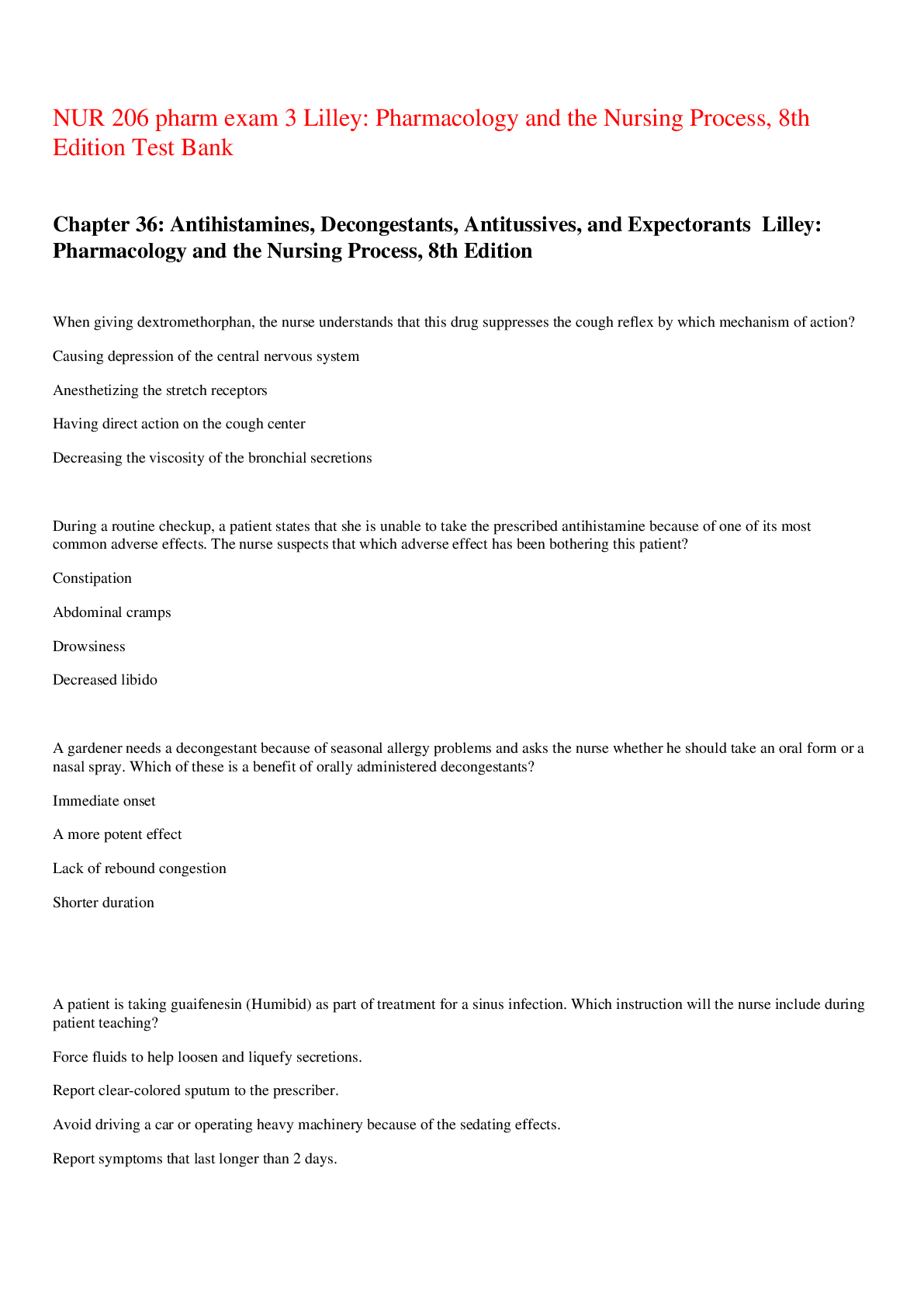
Reviews( 0 )
Document information
Connected school, study & course
About the document
Uploaded On
Mar 24, 2023
Number of pages
28
Written in
Additional information
This document has been written for:
Uploaded
Mar 24, 2023
Downloads
0
Views
47










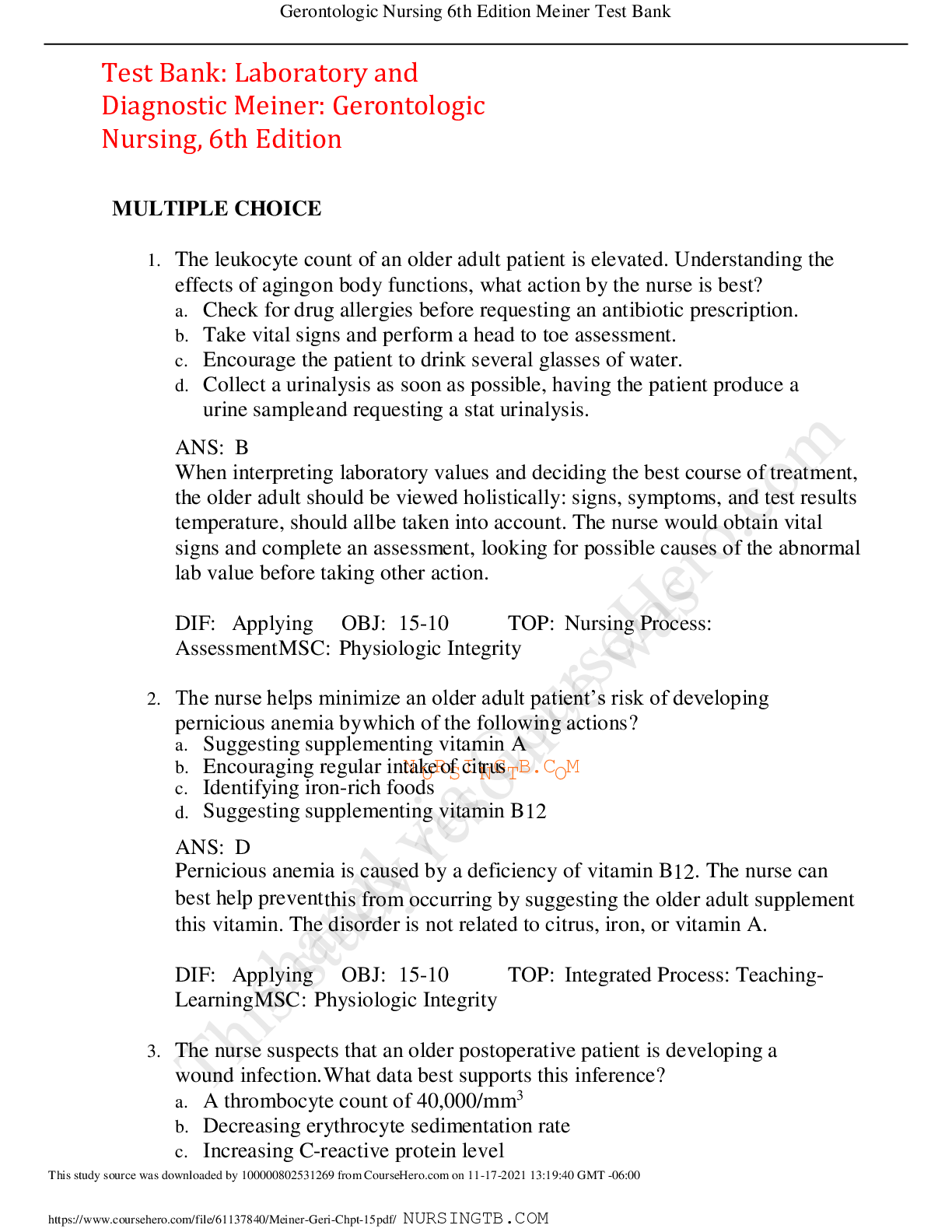


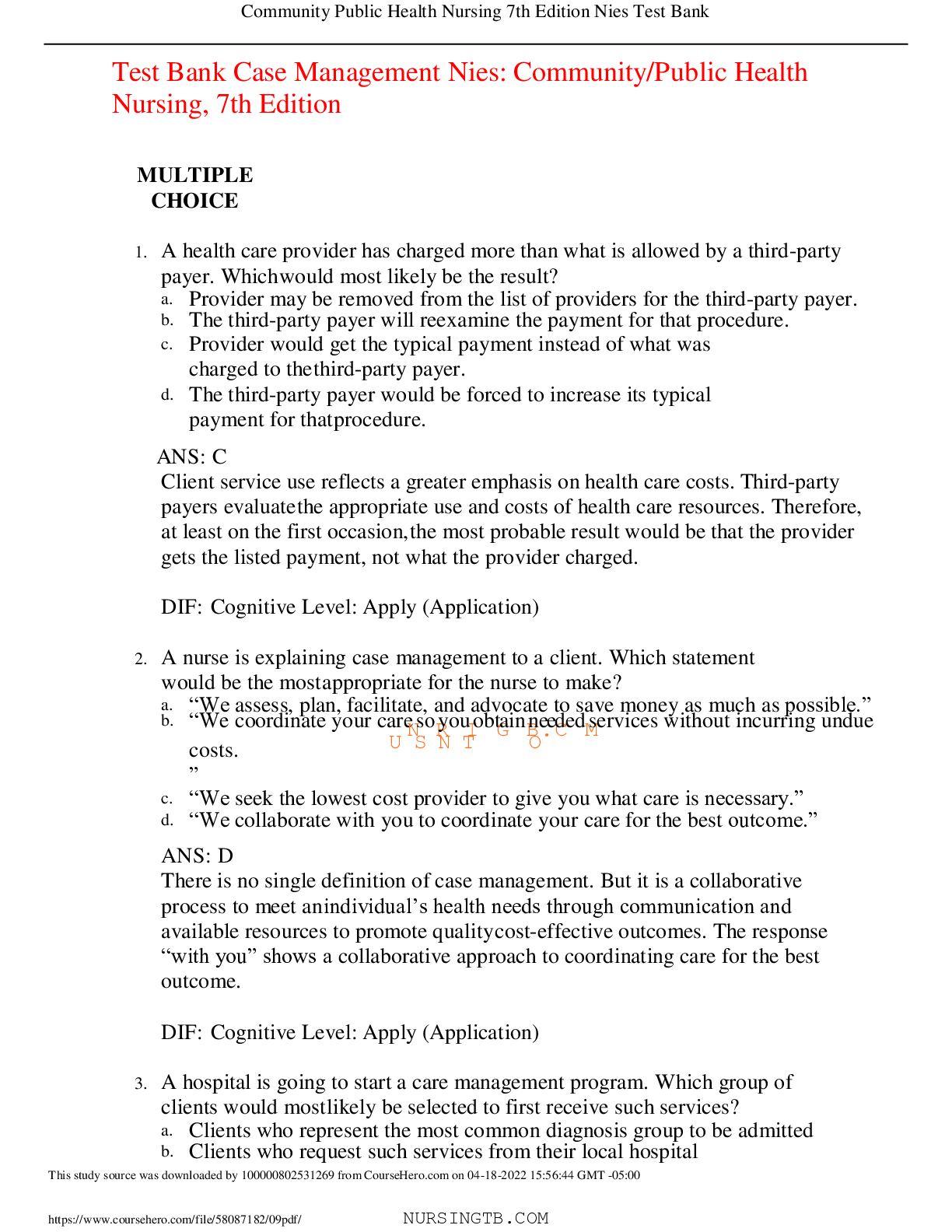


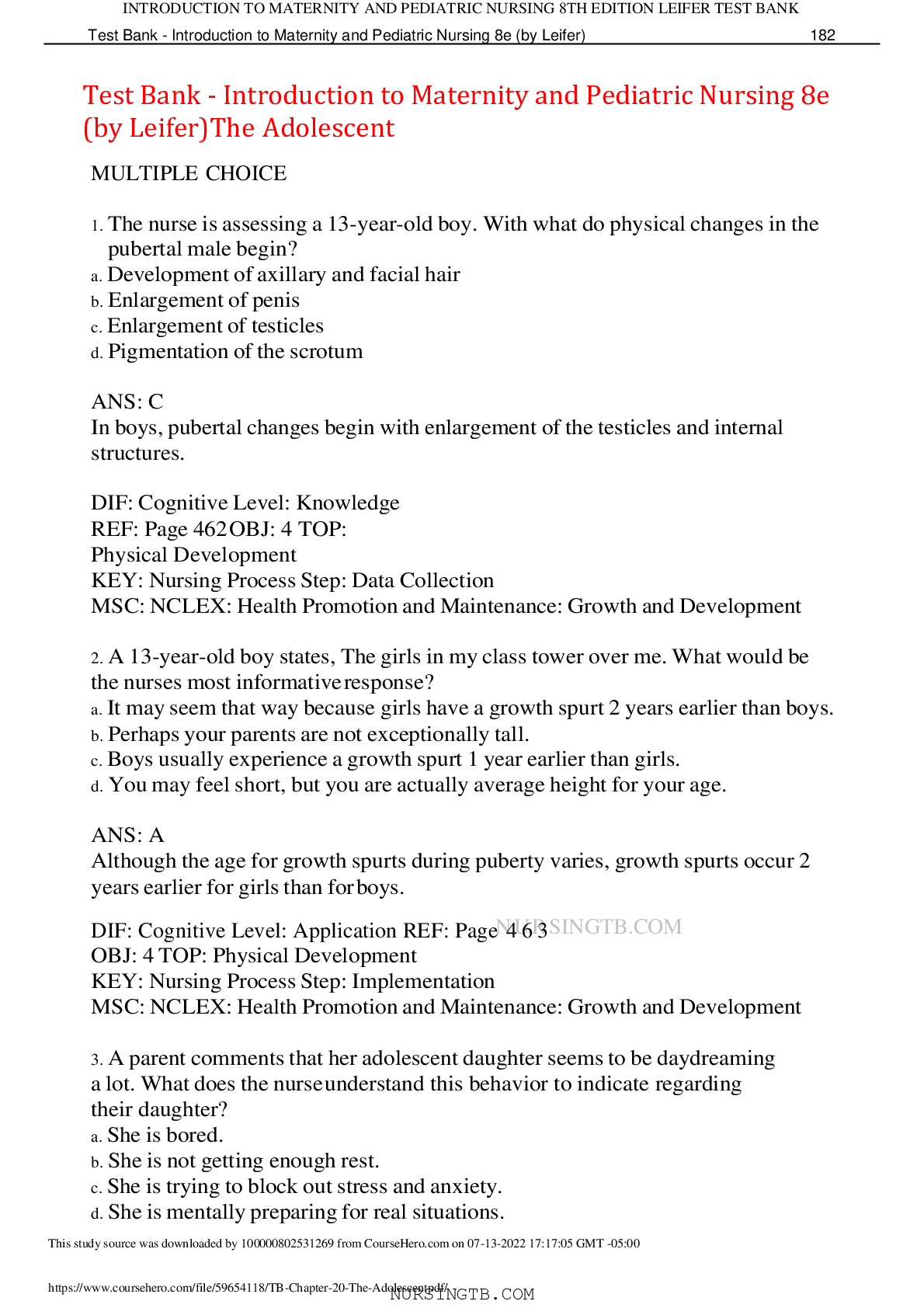




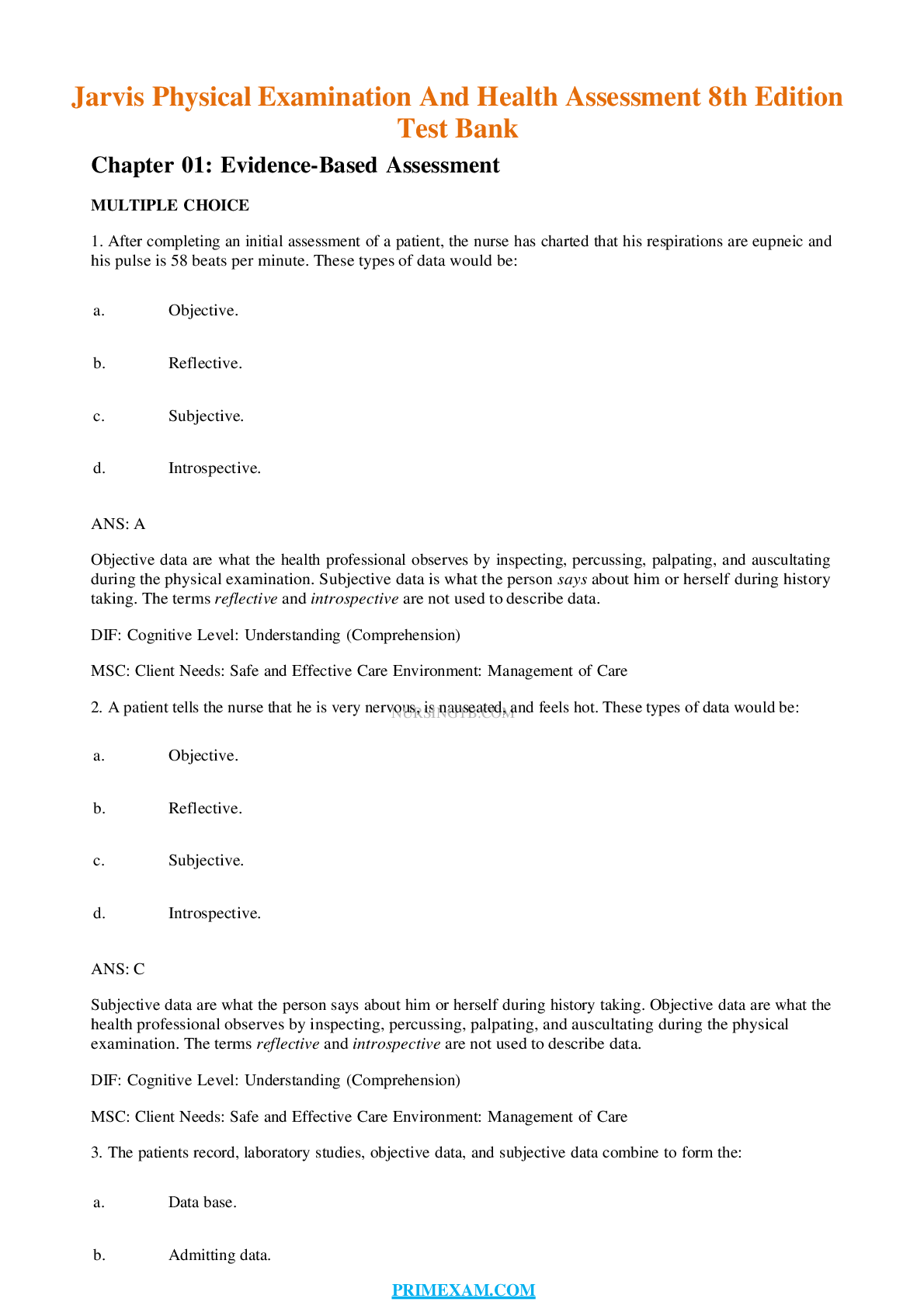


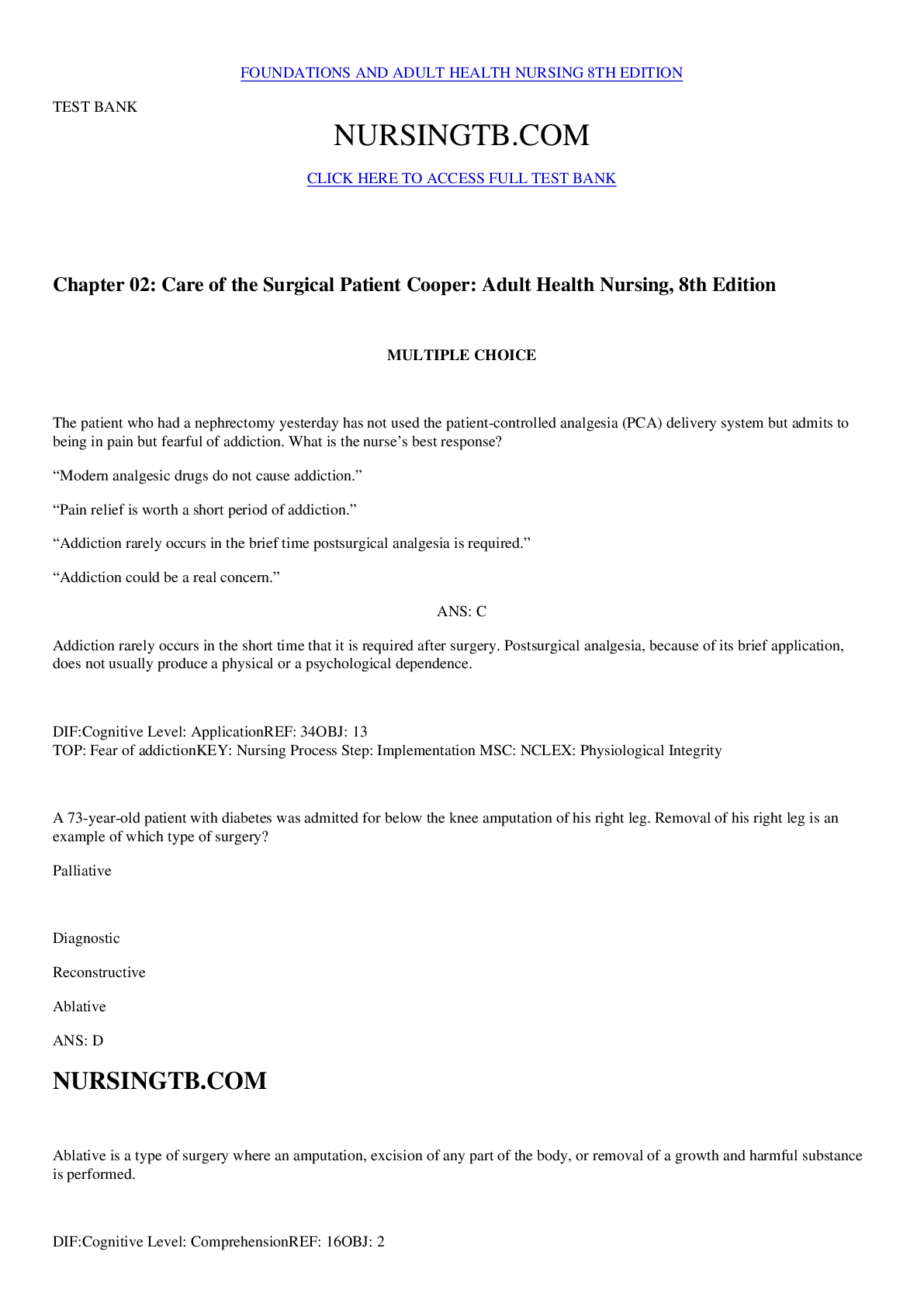

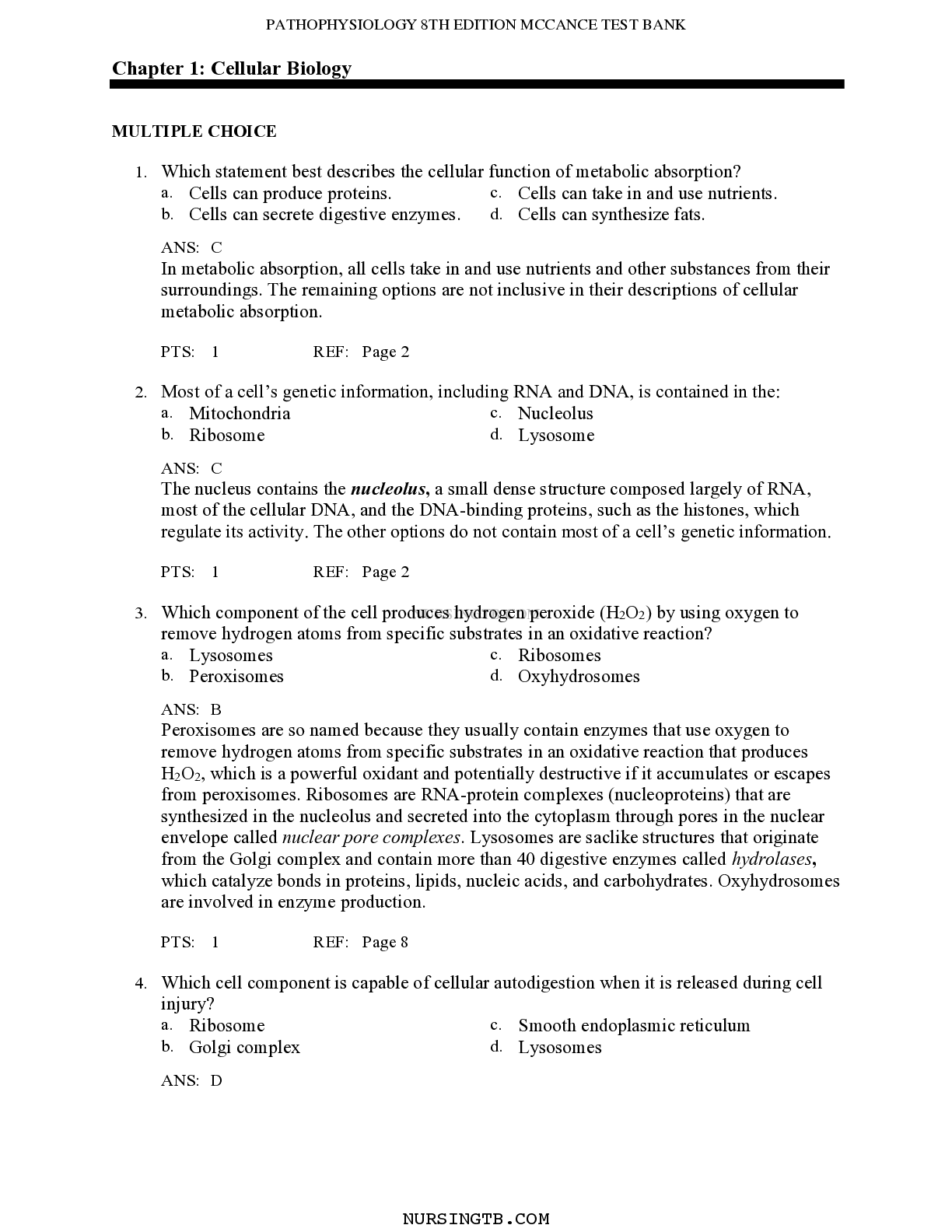
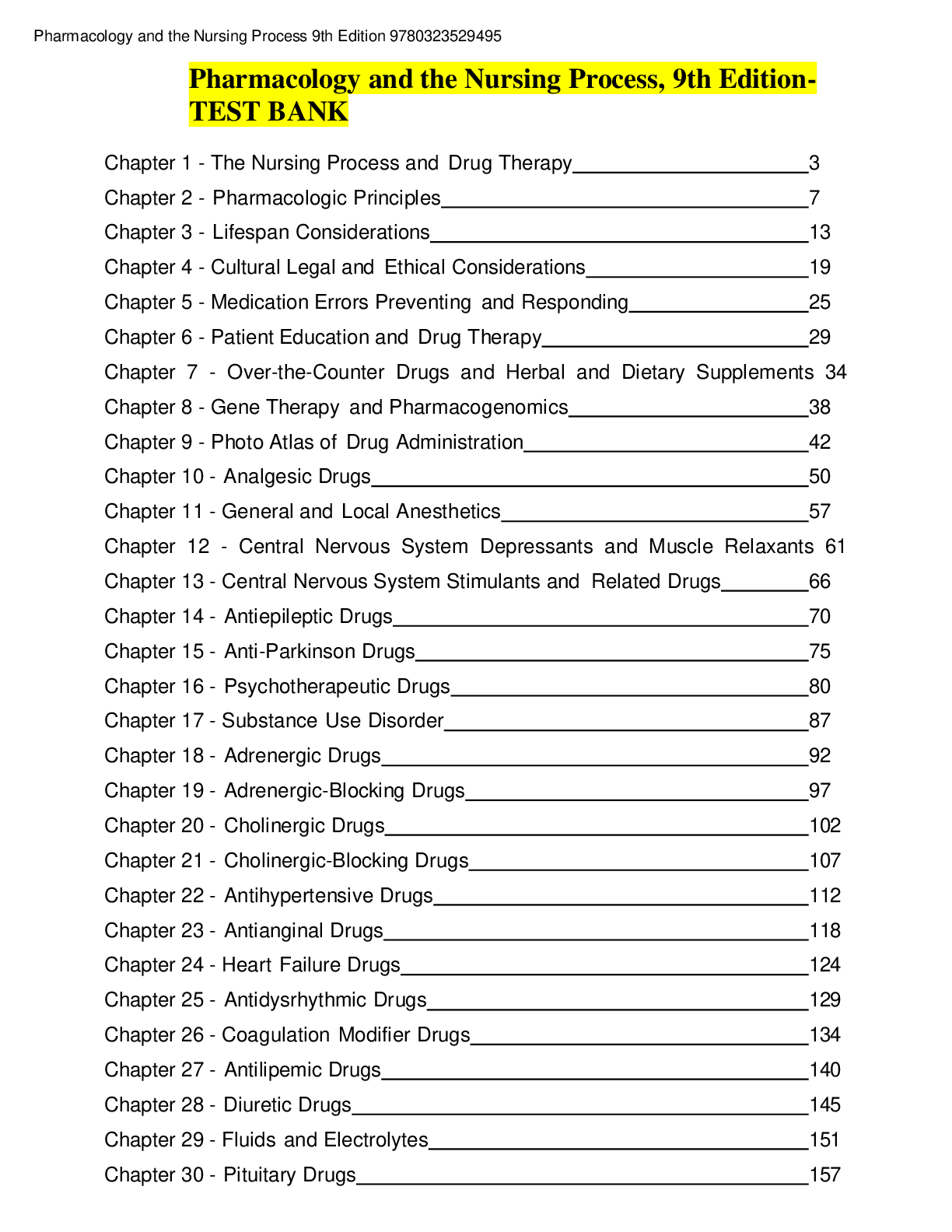

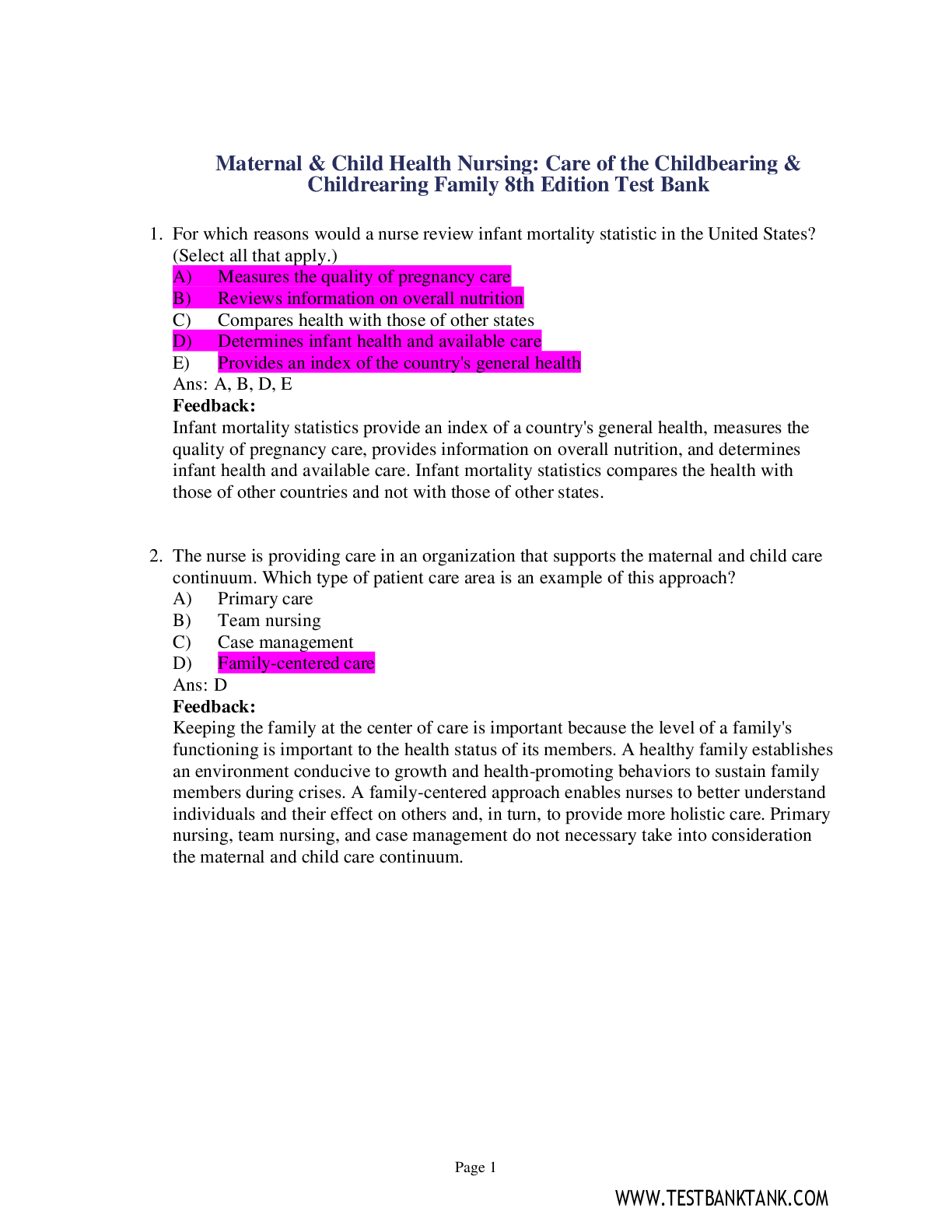
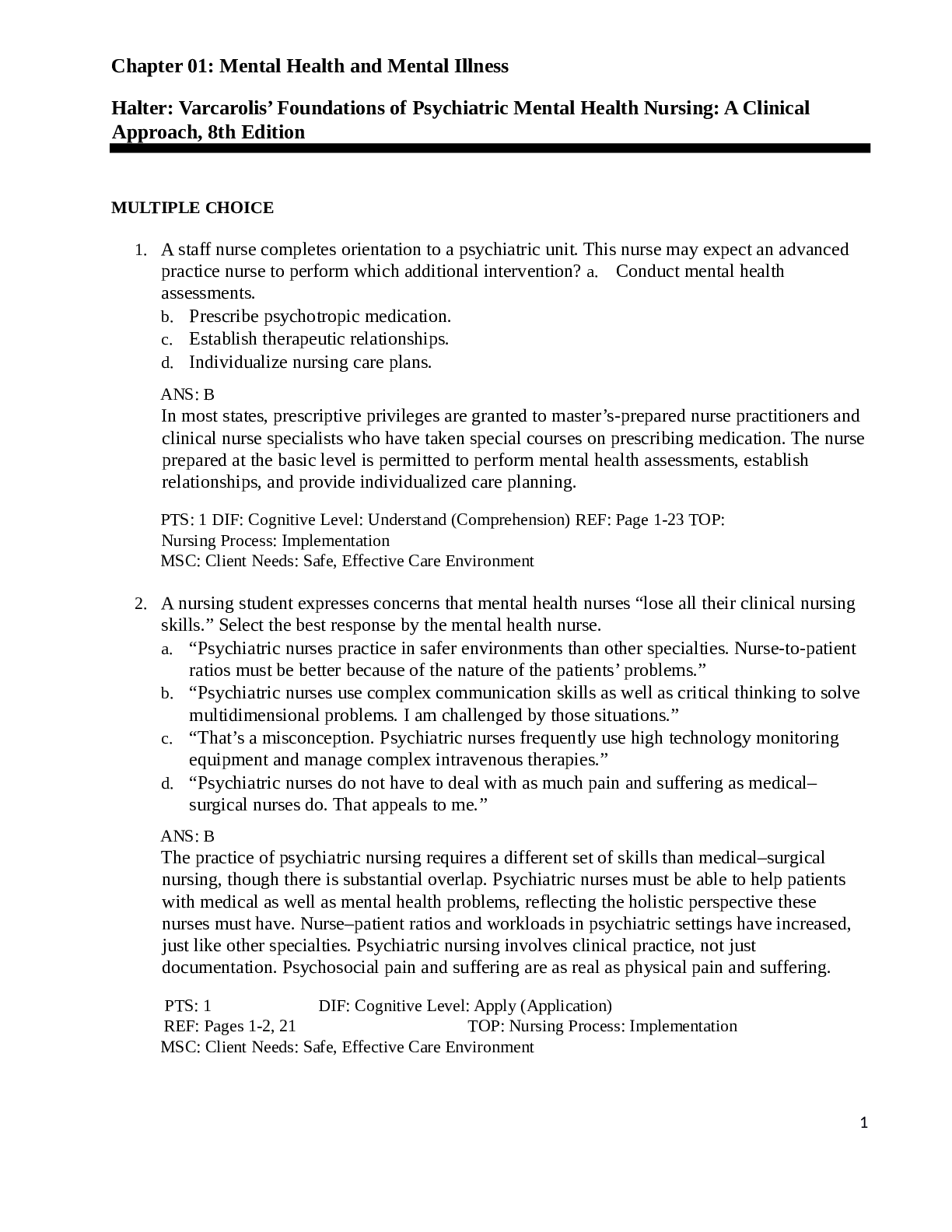

.png)
